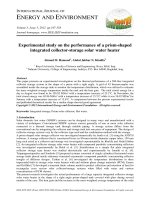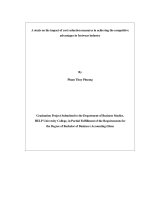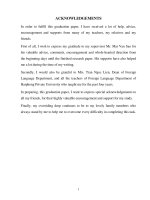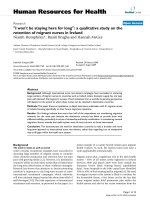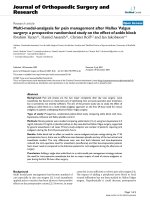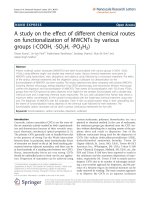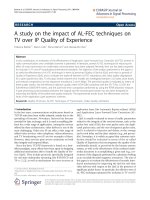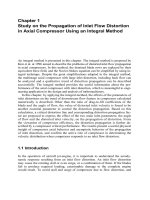Study on the propagation of inlet flow distortion in axial compressor using an integral method_3 pptx
Bạn đang xem bản rút gọn của tài liệu. Xem và tải ngay bản đầy đủ của tài liệu tại đây (355.05 KB, 10 trang )
21
X
0 250 500 750 1000
-0.2
0.0
0.2
0.4
0.6
0.8
1.0
1.2
α (0) = β (0) = 0.95
α (0) = β (0) = 0.70
M
.
k
D
/k
L
=1
θ
o
o
ψ
θ
=
*
*
=25
o
=10
M
.
k
D
/k
L
=1
θ
o
o
ψ
θ
=
*
*
=25
o
=10
M
.
k
D
/k
L
=1
θ
o
o
ψ
θ
=
*
*
=25
o
=10
M
.
k
D
/k
L
=1
θ
o
o
ψ
θ
=
*
*
=25
o
=10
M
.
k
D
/k
L
=1
θ
o
o
ψ
θ
=
*
*
=25
o
=10
M
.
k
D
/k
L
=1
θ
o
o
ψ
θ
=
*
*
=25
o
=10
M
.
k
D
/k
L
=1
θ
o
o
ψ
θ
=
*
*
=25
o
=10
M
.
k
D
/k
L
=1
θ
o
o
ψ
θ
=
*
*
=25
o
=10
Fig. 1.12. The asymptotic behavior of mass flow rate
α
β
0.7 0.8 0.9 1.0
0.0
0.2
0.4
o
θ
=25
o
o
24
(0) , (0)
o
θ
o
θ
o
θ
o
θ
=10
o
o
θ
.
o
θ
*
*
M
k
D
/k
L
=1
θ
o
ψ
θ
=
X
→∞
Fig. 1.13. The effects of degree of the initial distortion and the inlet flow angles
on the mass flow rate
flow rate. Besides, a higher mass flow rate will arrive at a larger asymptote. This
1.4 Results and Discussion
proportional relation between mass flow rate and inlet distorted velocity can
also be seen from Fig. 1.13. In conclusion, a smaller inlet distorted velocity and
larger flow angle may result in a low overall mass flow rate, even a back flow
(Fig. 1.13).
1.4.4 Critical Distortion Line
circle no. conditions distortion status
1
case 1
3.0
0x0x
=
=
==
β
α
growing.
2
case 1
5.0
0x0x
=
=
==
β
α
lessening.
3
case 1
7.0
0x0x
=
=
==
β
α
lessening.
3
case 2
0
0
15=
θ
lessening.
4
case 2
0
0
20=
θ
growing.
5
case 2
0
0
25=
θ
growing.
5
case 4
7.0
0x0x
=
=
==
β
α
growing.
6
case 4
95.0
0x0x
=
=
==
β
α
growing.
Chapter 1 Study on the Propagation of Inlet Flow Distortion 22
The results in previous paper [8], case 1, case 2 and case 4 expressed the distortion
propagation with respect to different inlet flow angle and different inlet dis-
torted velocity. These results are isolated and incomplete. A more suitable analysis
way is combining the two parameters, inlet flow angle and inlet distorted ve-
locity, into a single figure to form a curve, as shown in Fig. 1.14. We term the
curve with
0
0
=
−=
Δ
== xLx
ξ
ξ
ξ
as “critical distortion line”. Above the critical
distortion line,
0
0
>−=Δ
== xLx
ξ
ξ
ξ
, the distorted region will grow downstream
and become unstable. On the contrary, below the critical distortion line,
0
0
<
−
=Δ
== xLx
ξ
ξ
ξ
, the distorted region will reduce downstream and become
stable. This critical distortion line is a more complete expression for inlet distor-
tion propagation. The six numbering circles in Fig. 1.14 correspond to all results
in case 1, case 2 and case 4 of Table 1.1, and their results are listed in Table 1.2.
It is very worthy to note that with different size of distortion region, the com-
pressor performs with only one critical distortion line. In other words, the size of
distortion region has no influence on the critical distortion line. Therefore, the pro-
posed critical distortion line includes the principal effects at inlet.
Table 1.2 The corresponding relation between the numbering circles in Fig. 1.14
and cases calculated in previous paper [8]
23
α,β
θ
0.0
0.0
0.2
0.2
0.4
0.4
0.6
0.6
0.8
0.8
1.0
1.0
10 10
12 12
14 14
16 16
18 18
20 20
22 22
24 24
distortion growing
distortion lessening
°
Δ
ξ
=
0
Δξ>0
Δξ<0
(0)
(0)
12 3
4
56
Fig. 1.14. Critical distortion line
210
A)0(A +=
αθ
(1.95)
In establishing the correlation between stall inception and inlet distortion, the
critical distortion line is described mathematically using a distortion propagation
factor according to (1.95):
21
0
AA +
=
α
θ
ϕ
(1.96)
The region with
ϕ
>1 denotes where the propagation will grow and the region
with
ϕ
<1 denotes where the propagation will decay.
1.4.5 Compressor Performance and Characteristic
A pressure profile can be obtained by solving (1.56) together with (1.52), (1.53),
(1.54), (1.55). The inlet and outlet total pressure are written as:
1.4 Results and Discussion
From Fig. 1.14, the critical distortion line is nearly a straight line:
The two constants can be found out from Fig. 1.14:
43.9A
1
=
and
266.11A
2
=
.
2
011
2
022
in
0
out
0
)V2/(vP
)V2/(vP
P
P
+
+
=
(1.97)
Here, the inlet air is at the ambient atmospheric condition.
1
P and
2
P are inlet
and outlet non-dimensional pressure,
1
v and
2
v are inlet and outlet velocity
without distortion, respectively.
1.20 1.25 1.30 1.35
1.2
1.4
1.6
1.8
2.0
distortion growing
distortion lessening
Δ
ξ
=
0
Δξ>0
P
oin
⎯
⎯
P
oout
M
.
Δξ<0
Fig. 1.15. The compressor critical performance with
5.0)0( =
ζ
0
V2
u
=
φ
(1.98)
12
PP
p
−
=
ψ
(1.99)
Chapter 1 Study on the Propagation of Inlet Flow Distortion 24
The compressor performance corresponding to the critical distortion line as
shown in Fig. 1.15 is termed as a compressor critical performance. By changing
the size of inlet distortion region
)0(
ξ
from 0.5 to 0.0, the different results of the
compressor critical performance can be produced as shown in Fig. 1.16. The effect
of the size of inlet distortion region on the compressor critical performance agrees
with intuitive anticipation that larger size of inlet distortion region induces a de-
crease of total mass flux.
The non-dimensional velocity and pressure rise in Fig. 1.17 are defined as:
25
1.2 1.4 1.6 1.8 2.0 2.2
1.2
1.4
1.6
1.8
2.0
2.2
2.4
ξ(0)=0.5
ξ(0)=0.3
ξ(0)=0.1
ξ(0)=0.0
•
P
oin
⎯
⎯
P
oout
M
•
M
•
⎯
⎯
M
•
⎯
⎯
M
•
M
Fig. 1.16. The compressor critical performance with difference inlet distortion regions
φ
ψ
1.2 1.4 1.6 1.8 2.0 2.2 2.4
1.3
1.4
1.5
1.6
1.7
1.8
1.9
2.0
2.1
distortion growing
Δξ>0
distortion lessening
Δξ<0
Δ
ξ
=
0
p
Fig. 1.17. The compressor critical characteristic
1.4 Results and Discussion
The trend of
p
ψ
versus
φ
is similar to the compressor characteristic with
uniform flow. Therefore, the curve of
p
ψ
versus
φ
in Fig. 1.17 is another
way of describing the critical distortion line, termed the compressor
each point on it is corresponding to one pointcritical characteristic because
on the critical distortion line. On other hand, because the size of the distortion
1.5 Concluding Remarks
The integral method and previous results are investigated and developed. The
results show that the distortion region may vanish downstream with the lessen-
ing of
ξ
when 0dxd >
α
. The results of the effects of inlet distorted parame-
ters indicate that a low flux of mass, or even a back flow may be caused by the
smaller inlet distorted velocity or larger flow angle. Excepting the ratio of
drag-to-lift coefficients of the blade and the angle of flow as suggested by
parameter to control the distortion propagation. Among all parameters to control
the distortion propagation, the angle of flow and the value of distorted inlet
velocity are inlet parameters.
To express the distortion propagation correctly, a critical distortion line is pro-
posed to describe the effect of two main inlet parameters: the angle of flow
and the distorted inlet velocity, on the propagation of distortion. Further more,
corresponding to the critical distortion line, the compressor performance and char-
acteristic with distortion propagation are investigated.
This study is useful in understanding the axial physical behavior of compressor
and the response of compressor to an inlet distortion, so as to construct a parame-
ter which may correlate the inception of inlet distortion propagation. Finally, an
improved model to predict the onset of compressor flow instability due to inlet
distortion could be developed by means of the current integral method and results.
[8], the value of distorted inlet velocity is confirmed to be another essential
Chapter 1 Study on the Propagation of Inlet Flow Distortion 26
References
[1] Christensen, D., Cantin, P., Gutz, D., Szucs, P.N., Wadia, A.R., Armor, J., Dhingra,
M., Neumeier, Y. and Prasad, J.V.R., 2006, Development and demonstration of a
stability management system for gas turbine engines.
ASME Turbo Expo, GT2006-
90324, Barcelona, Spain, May 8-11, 2006.
[2] Chue, r. Hynes, T.P., Greitzer, E.M., Tan, C.S., and Longley, J.P., 1989, Calcula-
tions of inlet distortion induced compressor flow field instability.
International
Journal of Heat and Fluid Flow
, 10(3): 211-223.
[3] Day, I.J. , 1993, Active suppression of rotating stall and surge in axial compressors.
ASME Journal of Turbomachinery
, 115: 40-47.
region has no effect on the compressor critical characteristic, there is an uniform
compressor characteristic for compressor with and without inlet distortion. This
phenomenon confirms the active role of compressor in determining the velocity
distribution when compressor responds to an inlet flow distortion. In conclusion, the
integral method is a feasible approach to produce qualitatively correct results for
compressor, and it is hoping that to associate the current integral method with
existing model, we could predict the onset of stall accurately.
References 27
[4] Dhingra, M., Neumeier, Y., Prasad, J.V.R., Breeze-Stringfellow, A., Shin, H-W. and
Szucs, P.N., 2006, A stochastic model for a compressor stability measure.
ASME
Turbo Expo,
GT2006-91182, Barcelona, Spain, May 8-11, 2006.
[5] Greitzer, E.M. , 1980, Review-axial compressor stall phenomena. ASME Journal of
Fluids Engineering
, 102: 134-151.
[6] Greitzer, E.M. and Griswold, H.R., 1976, Compressor-diffuser interaction with circum-
ferential flow distortion.
Journal of Mechanical Engineering Science, 18(1): 25-38.
[7] Harry, III, D.P. and Lubick, R.J., 1955, Inlet-air distortion effects on stall, surge, and
acceleration margin of a turbojet engine equipped with variable compressor inlet
guide vanes.
NACA Report, NACA RM E54K26.
[8] Kim, J.H., Marble, F.E., and Kim, C.–J., 1996, Distorted inlet flow propagation in
axial compressors. In
Proceedings of the 6th International Symposium on Transport
Phenomena and Dynamics of Rotating Machinery
, 2: 123-130.
[9] Liu Luxin, Neumeier, Y. and Prasad, J.V.R., 2005, Active flow control for enhanced
compressor performance. AIAA paper-4017,
41st AIAA/ASME/ SAE/ASEE Joint Propul-
sion Conference
& Exhibition, Tucson Convention Center, Arizona, July 10-13, 2005.
[10] Reid, C., 1969, The response of axial flow compressors to intake flow distortion. In
Proceeding of International Gas Turbine and Aeroengine Congress and Exhibition,
ASME Paper 69-GT-29.
[11] Stenning, A.H., 1980, Inlet distortion effects in axial compressors. ASME Journal of
Fluids Eng
., 102(3): 7-13.
Appendix 1.A Fortran Program: Integral Method
This code solves the partial differential equation set of integral method (1.1), (1.2)
and (1.3) by using the fourth-order Runge_Kutta method.
1. The input data are
SITA1 :
0
θ
flow angle at inlet, (1.6)
SKL :
L
k lift coefficient, (1.12)
DL :
LD
kk the ratio of drag-to-lift, (1.21)
Y(0) :
)0(
δ
vertical extension of distorted flow at inlet
DX :
x
Δ
, spatial increment along x direction
XL :
L
, ending position of x
ALFA(1,1):
)0(
α
, x- direction velocity increment in the distorted inlet region at
inlet
ALFA(2,1):
)0(
β
, y- direction velocity increment in the distorted inlet region
ALFA(3,1):
)0(
0
α
, x- direction velocity increment in the undistorted inlet
region
ALFA(4,1):
)0(
0
β
, y- direction velocity increment in the undistorted inlet
region
ALFA(5,1): P(0), pressure at inlet
2. Assumptions:
Referential local flow directions relative to a stator and a rotor: SITAS=PSAIS=10
(
*
θ
=
*
ψ
=10
0
).
At inlet,
0.1)0()0(
00
==
β
α
, )0(
α
= )0(
β
.
3. Output results can be found in the data file: OUTPUT.DAT, in which, there
are:
DY1 :
)0()L(
δ
δ
− , the increment of vertical extension of distorted flow
DU0 :
γ
βα
2
2
0
2
0
+
DP12 :the pressure difference between outlet and inlet, (1.99)
DU :
γ
δβαδβα
2
)1/(/
2
0
2
0
22
−+++
DM :no-dimensional mass flow rate, (1.94)
DP0 :the ratio of outlet to inlet total pressure, (1.97)
Some variables are explained in the code after “!”.
Chapter 1 Study on the Propagation of Inlet Flow Distortion 28
PROGRAM RG_KT4
*************************************************************
* COMPRESSOR INTEGRAL SOLVER *
* FUNCTIONS: VELOCITIES, PRESSURE *
* METHOD: FOURTH-ORDER RUNGE-KUTTA *
*************************************************************
PARAMETER (NDX=100000)
DIMENSION FXU(NDX),FX0U(NDX),FYU(NDX),FY0U(NDX),A(5)
DIMENSION X(NDX),Y(NDX),ALFA(5,NDX),RK(4,5,NDX),F(5,NDX)
DOUBLE PRECISION RK,X,Y,ALFA,FXU,FX0U,FYU,FY0U,DX,F,
& SKD,SKL,SITA0,SITAS,PSAIS,GAMA,CK0,CK1,CK2,CK3,
& PI,DL,FX01,FX02,FX03,FX04,FX05,FX06,FX07,FX08,
& FY01,FY02,FX1,FX2,FX3,FX4,FX5,FX6,FX7,FX8,FY1,FY2,
& A,AL0,AL1,SI0,SI1,DSI0,DY,DY1,SITA1,DM,DM1,
& DP01,DP02,DP0,DP12,DU1,DU2,DU,DU0,A1,A2,A3
OPEN(1,FILE='OUTPUT.DAT')
PI=4.*ATAN(1.0)
****** PREPARE INITIAL DATA ********
SITA1=12.6
SITAS=10.*PI/180.
PSAIS=10.*PI/180.
SKL=3. ! KL
DL=1.0 ! KD/KL
SKD=DL*SKL ! KD
Y(1)=0.0001 ! DELTA/(PI*R)
DY=0.1
DSI0=0.2
X(1)=0. ! INITIAL POSITION OF X
DX=0.001 ! SPACIAL INCREMENT ALONG X DIRECTION
XL=1. ! ENDING POSITION OF X
ALFA(1,1)=0.06 ! ALFA
Appendix 1.A Fortran Program: Integral Method 29
ALFA(2,1)=ALFA(1,1) ! BETA
ALFA(3,1)=1. ! ALFA0
ALFA(4,1)=ALFA(3,1) ! BETA0
ALFA(5,1)=0.0 ! PRESSURE
1 SI0=SITA1
SITA0=SITA1*PI/180.
GAMA=TAN(SITA0)
AL0=ALFA(1,1)
DAL0=0.001
AL1=ALFA(1,1)
10 CK1=Y(1)*ALFA(1,1) ! K1
CK0=CK1+(1-CK1/ALFA(1,1))*ALFA(3,1) ! K0
****** END OF INPUT ********
****** ITERATIVE CALCULATION FROM X=0 TO X=500 **********
I=1
20 I=I+1
X(I)=X(I-1)+DX
****** FORCE COMPONENTS ********
****** (1) DISTORTED REGION:
FX1=ALFA(1,I-1)**2+((2 ALFA(2,I-1))*GAMA)**2
FX2=(2 ALFA(2,I-1))*GAMA/ALFA(1,I-1)-TAN(PSAIS)
FX3=(2 ALFA(2,I-1))*GAMA/ALFA(1,I-1)*(1 DL)+
& DL*TAN(PSAIS)
FX4=ALFA(1,I-1)/(SQRT(ALFA(1,I-1)**2+
& ((2 ALFA(2,I-1))*GAMA)**2))
FX5=ALFA(1,I-1)**2+(ALFA(2,I-1)*GAMA)**2
FX6=ALFA(2,I-1)*GAMA/ALFA(1,I-1)-TAN(SITAS)
FX7=ALFA(2,I-1)*GAMA/ALFA(1,I-1)*(1 DL)+
& DL*TAN(PSAIS)
FX8=ALFA(1,I-1)/(SQRT(ALFA(1,I-1)**2+
& (ALFA(2,I-1)*GAMA)**2))
Chapter 1 Study on the Propagation of Inlet Flow Distortion 30
